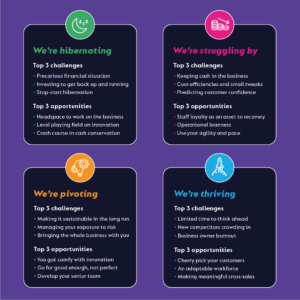Leadership & Strategy
Article
Thriving in a pandemic? How SMEs can sustain success
 So you’re thriving. By good luck or good judgment, your business has been able to significantly ramp up production. You might even have taken on more staff or invested in additional capacity.
So you’re thriving. By good luck or good judgment, your business has been able to significantly ramp up production. You might even have taken on more staff or invested in additional capacity.
Businesses deemed essential such as PPE manufacturers and supermarkets aren’t the only ones that sit in the Thrivers segment. We’ve seen huge growth for software service providers, health and wellbeing companies, entertainment streamers and food and drink makers.
Although our recent survey found that only six per cent of business leaders consider themselves to be doing better than ever, it’s likely that more firms will begin joining this segment as we begin to reopen our economy.
But being a Thriver is not all roses, is it? We’ve spoken to other business owners who are thriving to find out what they’re focusing on in the short-term and how they view the months ahead. Here are the key challenges and opportunities they identified:
Challenges for thriving SMEs
- Limited time to think ahead. Leaders in thriving businesses are all hands on deck coping with demand. But to see long-term growth find time to think what your emerging reality could be when temporary demand dies down and many consumers resume old buying patterns. Thriving beyond recovery is your biggest challenge.
- New competitors crowding in. Thriving sectors are likely to attract new entrants. Whether it is by innovation, action or advertising you need to make it as easy as possible for customers to stick with your brand rather than reconsider their options. Use the head start you have to make sure your brand value and USP is clear.
- Business owner burnout. If your business has been at full capacity for weeks, that means you might also be facing significant strain on your personal capacity as leader. Your ability to make quick decisions and look after the needs of your employees is essential to the sustainability of what you’re doing. Managing relentless change takes a toll.
Opportunities for thriving SMEs
- Cherry-pick your customers. You’ve got a whole load of new customers without paying the usual costs of acquisition. Now’s your chance to do some lifetime value analysis to understand your new customer base. Decide who’s going to be most valuable to you over time and focus budget on marketing to them and retaining them.
- Adaptable workforce. Your staff have proven they’re capable of embracing a new working culture without dropping their productivity. This gives you a lot of wriggle room to experiment as a business. Whether you want to try out new working patterns, new product lines or new processes, it’s less risky if your people can flex with you.
- Meaningful cross-sales. If you’re currently thriving thanks to the popularity of a particular product or service, drive revenue by cross-selling related, bundled or add-on items. This could be a good way to widen your product/service range, create value for customers and de-risk your operations.
What’s next for thriving SMEs?
There’s a lot of talk about bouncing back, but for some businesses, recovery isn’t going to be feel much like “bouncing”. Like all surveys, our research puts businesses in clear-cut segments. In reality though, the lines between Thrivers, Strugglers, Hibernators and Pivoters are not static. Today’s thrivers might find themselves in a very different place tomorrow with changing guidance from government and the ebbs and flows of lockdown. Over the next 12 months you might move in and out of these definitions as we all regroup and figure out what the future holds. (Eventually let’s hope you’ll all be thriving.)
As you work through your own rebuild puzzle, here are the phases you might be going through:
Thriver stories
Float
Float, a budgeting and cash flow forecasting business, is a great example of a thriving firm. During lockdown, its services became extremely popular with small businesses – signups up grew six-fold compared to pre-pandemic levels. The business decided to offer a free trial for businesses impacted by coronavirus along with increased customer support resources and educational materials. To deal with volume, it also began delivering support via masterclasses and training webinars instead of one-to-one calls.
Colin Hewitt, CEO and founder of Float, said: “Between February and March, we experienced a 65 per cent increase in customers trialling Float. The free trial period is coming to an end soon and we’re working hard to retain as many of these new customers as possible.”
Before the pandemic hit – Float was a team of 21, primarily based in Edinburgh with an office of two people in Australia. But the pandemic ultimately resulted in four new remote hires. Hewitt praises the way his staff have responded to increased demand. “The team at Float have really rallied and supported one another. Our biggest focus now is making sure that the team feels supported working remotely and are not burning out.”
About 18 months ago Float hired its current COO, Jen Given, a former accountant and all-round financial whiz. Colin said she’s been instrumental in Float’s own planning and forecasting. ”Jen has really helped us be conscious and cautious about not being too reactive and overextending.”

Read our full Q&A with Float’s Colin Hewitt
Creative Nature
Creative Nature, a free-from snack and baking mix brand, is another great example of a thriving company. Creative Nature have seen a rise in demand across several channels: Amazon (over 650 per cent), Ocado (44 per cent), as well as a 280 per cent increase from its own website.
CEO and founder Julianne Ponan said: “As soon as we realised this was going to be the way many consumers were choosing to shop at this time we diverted marketing spend that way. We’ve found new avenues and tapped into areas we would never have thought of before by thinking out of the box – such as supplying essential food boxes, looking at garden centres, pharmacies and other places that have been able to be open throughout.”
It’s been the company’s busiest period and a steep learning curve as it scaled up. “It’s certainly been a learning curve so far. The business has had to move manufacturing to meet demand and get new equipment and training to make sure we keep supply and distribution going. There has also been a need to take on more warehousing space because forecasting for across various lines has been difficult.”
Conscious of the need to sustain its success in the long term, Julianne outlined plans for retention. “We’re speaking more with our direct customers, which has been fantastic as interacting more has enabled me to see what our customers like, what they don’t like and get great feedback on the products whilst driving trial. We intend to keep in touch with customers via our social media channels and our email marketing to encourage them to stay with us. each decision I have made with the team has been thought about in terms of what this will look like in six, 12 or 18 months time. Could this hinder help the business with new avenues. I think it’s important that, during times like this, you react fast – but not without calculating risk.”

Read our full Q&A with Creative Nature’s Julianne Ponan
Tonic Health
Tonic Health is London-based provider of super-high strength vitamin supplements. With the media and consumers thinking more about immune health, there’s been a huge increase in sales that’s seen the business grow by 1000 per cent since March. Pre-pandemic it was primarily focused on physical retail channels with stores making up 95 per cent of sales. Once the pandemic kicked in the business shifted focus to online and has seen a dramatic shift with business moving to 50/50 in terms of retail to online.
According to founder Sunna van Kampen the downside of demand surge is that the focus has been taken off new product development. “A lot of retailers have put on hold range reviews and new product launches for the remainder of the year. This will delay our plans and growth into 2021 as retailers are focused on availability of current lines and limiting store change hours as much as possible.”
The cost of raw ingredients has also gone up significantly as a result of increased demand and reduced production capacity due to social distancing measures in the factories. Scaling up to delivering high volume has been a challenge. “There was definitely a pain point where we were answering customer emails at 11pm at night to keep up,” revealed Sunna. “Then we had an out-of-stock situation for three weeks where we were trying and keep everyone happy whilst not losing sales. To help alleviate these issues we’ve recruited a new customer service manager and paid thousands in air freight to get goods into the UK quicker.”
Consumer behaviour has shifted to a focus on prevention and regular immune support. Sunna said the business will be looking at consumer behaviour to shape its product pipeline and how to retain new customers. “We’ve got a 30-40 per cent retention rate and we are working hard to help our customers on their immunity journey by providing useful content, insightful science and thought leadership to help keep them not only healthy through taking our product but also in their lifestyle choices.”
Read our full Q&A with Tonic Health’s Sunna van Kampen

